Mikołajki
Borough of Łomża, Łomża District, Podlaskie VoivodshipType of place
An easement field outside of the village, approx. 100 metres away from the buildings / Woods near the village on the way to the village of Jarnuty (during the war owned by Piotr Cholewicki.)Information about the crime
Three Jews (two men and one woman) were hiding in Mikołajki in a Polish farmer Antoni Kenigsman’s outbuildings. In May 1942 their hideout was discovered by the military policemen from Miastkowo. The then mayor called Plona, ordered by the Germans, gathered several men to search Kenigsman’s outbuildings. One of the hiding men was killed on the spot and the farmer was heavily beaten. The remaining Jews were taken to the woods outside of the village and murdered next to a previously dug ditch into which the body of the third murdered Jew was also thrown.
Ryszard D., a resident of Mikołajki born in 1936, told us about this event in August 2017: “They searched the barn and found meat. They beat up Kenigsman. They were beating him heavily, drawing blood. They threw hay around and must have got close to the Jews because a young Jew, I don’t know how old he was, jumped out of the pigsty. While jumping he must have fallen over and they shot him in the back with an automatic gun. My neighbour, born in 1929, saw them being shot.” (Mikołajki, 18 August 2017.)
In 1970s witnesses testified about this case as a part of an investigation into crimes committed by the German military police from the police station in Miastkowo:
The testimony of Józef T. (S 164/69) from 6 June 1973:
“As far as I remember in May 1942 the military policemen from Miastkowo and Gestapo officers from Łomża arrived in our village. First, they took Stanisław Gudelski who lived in the colony and when they arrived in the village [Mikołajki] they took Antoni Kenigsman. They searched the outbuildings owned by the latter and found two Jewish men and a Jewish woman hiding. […] One of the Jews was killed on the spot. I heard gunshots and then, when I came closer, I saw the body of the murdered man lying on Kenigsman’s yard. It was a man called Całka, about 60 years old merchant. He came from Łomża. […] The body of the murdered man was buried outside of the village approx. 100 metres away from the buildings on an easement field – as ordered by the military policemen and in their presence. I’d like to mention that the other Jewish man and the Jewish woman were shot to death at the site of the burial of the first one. They were buried together.”
The testimony of Antoni Ch. (S164/69) from 12 June 1973:
“One morning the military policemen and Gestapo officers arrived in our village [Mikołajki.] […] They called me to the yard of Kenigsman’s house. I was standing there watching the Germans searching the barn. […] Then they searched the pigsty and found Jews who were hidden [there] by Kenigsman. I’d like to mention that when I arrived at Kenigsman’s yard the owner of the property was lying on the ground in the barn. He was covered in blood and couldn’t move. After discovering the Jews, the military policemen took them to the yard and started beating them. One of them was called Całko. I knew him personally. It was a miller from Szczepankowo. […] One of the military policemen […] shot Całko with a series from an automatic gun killing him. Then he approached the lying man and shot him in the head. Then the military policemen ordered us to dig a ditch. We went to the woods owned by Piotr Cholewicki and we dug a hollow there. […] I heard that the military policemen took the Jewish man and woman to this hollow and shot them there. They also threw the body of Całko there.”
During the site inspection on 18 August 2017 Ryszard D. showed us the place in the forest where the murdered Jews had been buried.
Commemoration
The place of the grave was marked with a wooden matzevah as part of the project “Reference points”. The project is an attempt to find a way to mark these places before they can be commemorated. The action was aimed as an intervention in the landscape of these places, which would remind about what remains invisible, even if present in the memory of local communities.Being only a temporary commemoration, wooden matzevot invite local communities to discuss and take action, to discover the places, and perhaps to start their own memory practice related to them or to permanently commemorate them.
You can read more about the project here (English below):
https://zapomniane.org/wp-content/uploads/2018/10/MACEWY_punkty-odniesienia_folder.pdf
The project of marking graves with wooden matzevot has been carried out by the Zapomniane Foundation since 2017. in constant cooperation with The Matzevah Foundation.
IDENTIFICATION OF THE GRAVE BASED ON NON INVASIVE RESEARCH
On the 2nd of October 2017, a GPR survey was carried out (GPS: N53°08.210′E021°58.498′) giving inconclusive results.
The LIDAR survey didn’t reveal any precise changes in the topography of the terrain.
The aerial photography query for this area wasn’t ordered.
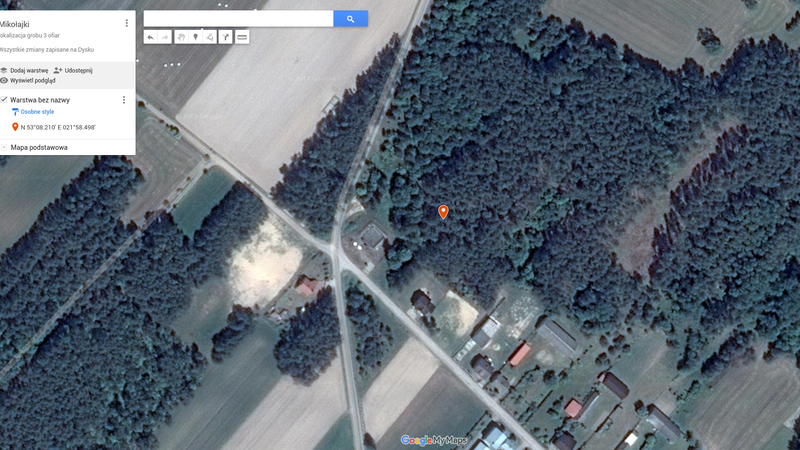 Mikołajki fotografia satelitarna 1f
Mikołajki fotografia satelitarna 1f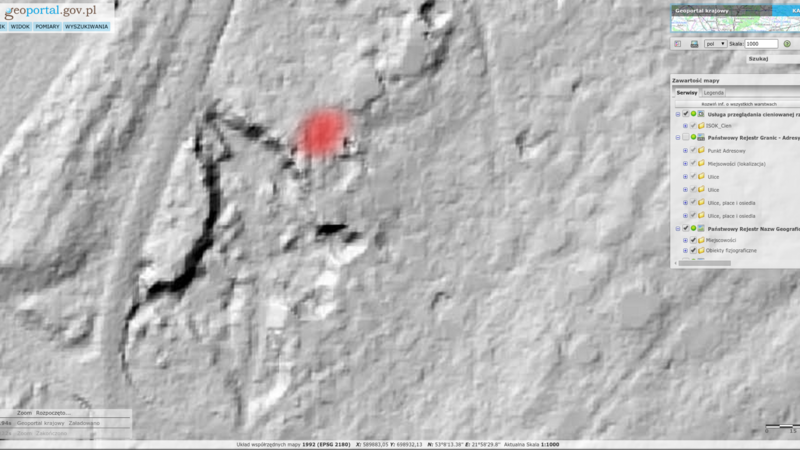 Mikołajki lidar 1d
Mikołajki lidar 1d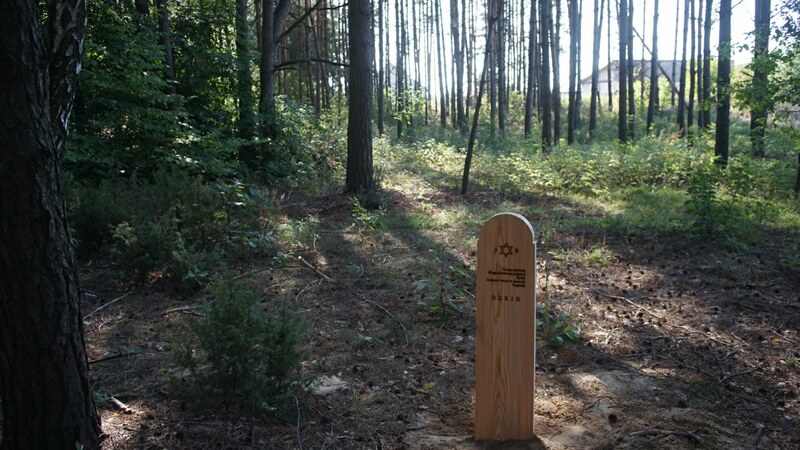 Mikołajki
Mikołajki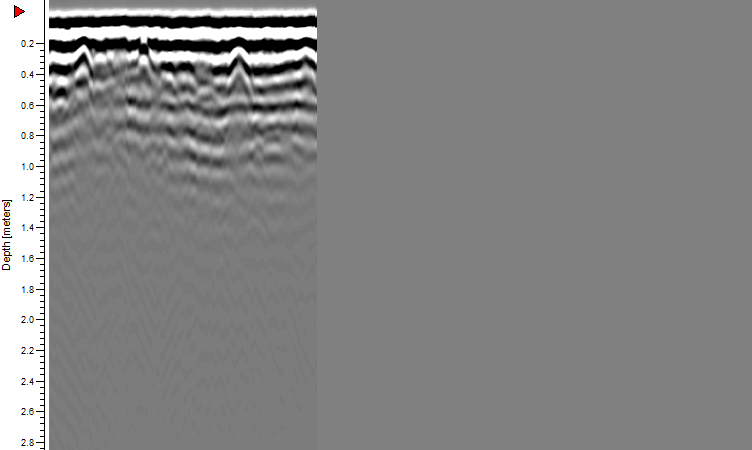 Mikołajki MIK_0001
Mikołajki MIK_0001Sources
Contact and cooperation
We are still looking for information on the identity of the victims and the location of Jewish graves in Mikołajki. If you know something more, write to us at the following address: fundacjazapomniane@gmail.com.
Bibliography
Recording of the Zapomniane Foundation (audio file), name: Ryszard [witness to the story], b. 1936, subject and keywords: Jewish graves in Mikołajki, interviewed by Agnieszka Nieradko, Mikołajki, 18 August 2015.
DS 164/69, Files on criminal offenses committed by German gendarmes from Miastków, Łomża district in Miastków and surrounding villages in 1941-44, p. 26-28, 70, 71, 82-86, 176 (photographic documentation: “Photo showing the place of murder of one Jew in the yard of Antoni Kenigsman by German gendarmes in 1941. “” A photo showing the place of murder – shooting of two Jews and the place of their burial in 1944 ”
The register of sites and crimes committed by the Germans in Poland between 1939 and 1945, łomżyńskie province, Warsaw 1985. P. 142-143.
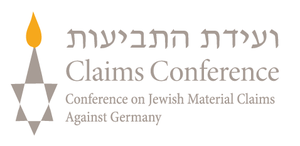
In appreciation to the Conference on Jewish Material Claims Against Germany (Claims Conference) for supporting this research project. Through recovering the assets of the victims of the Holocaust, the Claims Conference enables organizations around the world to provide education about the Shoah and to preserve the memory of those who perished.

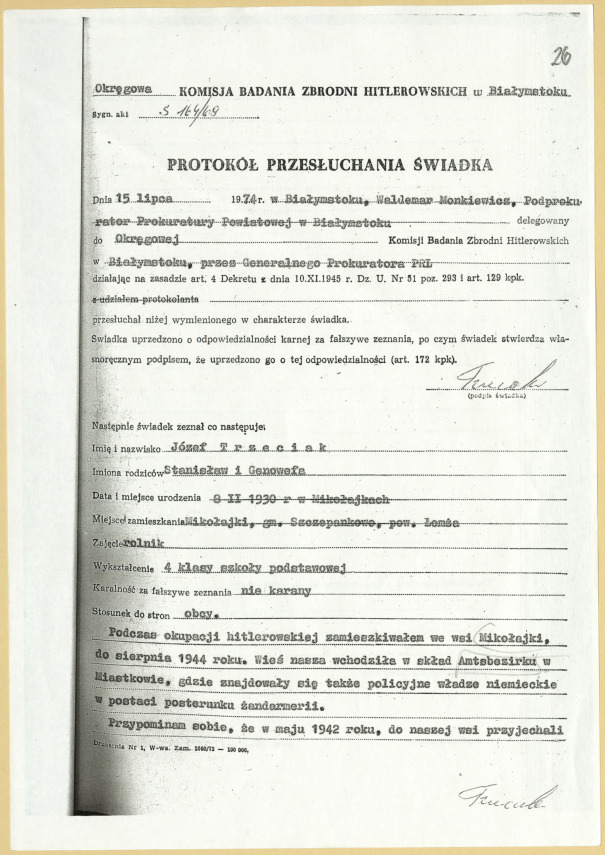 Akta w sprawie karnej zbrodni popełnionych przez żandarmów niemieckich z Miastkowa pow. Łomża na terenie Miastkowa i okolicznych wsi w latach 1941-44
Akta w sprawie karnej zbrodni popełnionych przez żandarmów niemieckich z Miastkowa pow. Łomża na terenie Miastkowa i okolicznych wsi w latach 1941-44